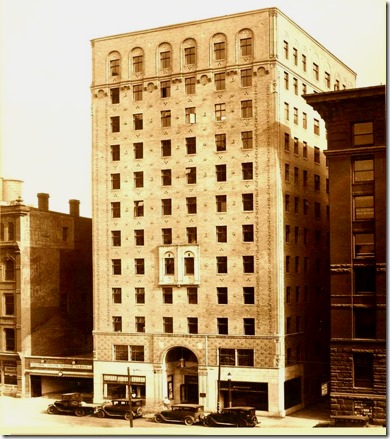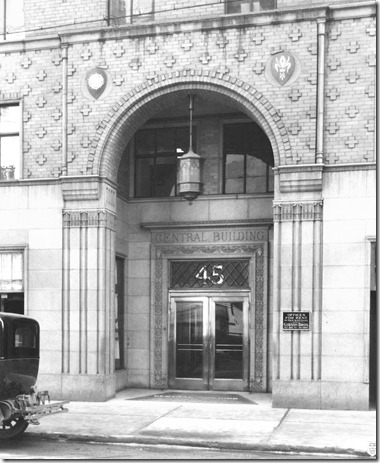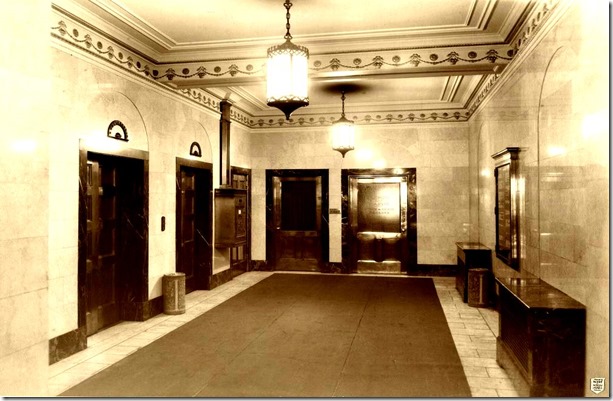The Central Building on the south side of Richmond Street West, between Yonge and Bay Streets, c. 1928. Toronto archives, F 044, Item 0021.
The Central Building at 45 Richmond Street West was not among the structures that architectural preservationists would likely have fought to save from the wrecker’s ball. Built between 1927 and 1928, it was rather plain, its facade containing few architectural ornamentations. It was an oddity for the decade in which it was constructed, as most 1920s commercial buildings tend toward a little more exuberance. Its architects were Baldwin and Greene, who also designed the Concourse Building at 100 Adelaide Street West. In contrast to the Central, it contained one of the finest Art Deco facades in the city. Today, its south facade remains much admired. If the Central Building had survived, I doubt that it would elicit the same respect and admiration that the Concourse building has generated.
The Central’s architects also created the Claridge Apartments, on the southwest corner of Avenue Road and Clarendon, three blocks south of St. Clair Avenue. Its ornate Romanesque architecture, with a lobby decorations by The Group of Seven’s J. E. H. MacDonald, is a testament to the skills and artistry of Baldwin and Greene.
The 12-storey Central Building was constructed of beige bricks, its north facade possessing only a few elements of Art Deco design. On the side of this facade, near the corners of the building, there were faux ancient hieroglyphs, which began on the 3rd floor and ascended to the 11th. The cornice at the top was exceedingly unornamented, but the sub-cornice below it, possessed a few interesting designs in the brickwork. However, these details were lost to those who strolled by on the sidewalks as they were too high to be seen on the narrow street where it was located. In contrast, the two-storey entrance on the ground floor was well ornamented and contained an impressive Roman arch. On the fifth floor, in a central position, was a rather odd looking bay window. There is no record of why this was included, but I assume that the room behind it had special significance, such as a board room or a chief executive’s office.
The building was demolished to create a parking lot to accommodate the many cars that daily enter the city’s downtown core. I was unable to discover the date of the building’s demise, but it was likely in the 1940s or 1950s.
Entrance to the Central Building at 45 Richmond Street. The doors were recessed into the archway. Toronto Archives, S 044, Item 0020.
The generous use of marble, the decorative ceiling, and light fixtures reflect the best of the Art Deco period. Toronto Archives, F 044, Item 0022.
Location of the Central Building at 45 Richmond Street West.
Source: “Toronto Architecture, a City Guide,” by Patricia McHugh.
To view the Home Page for this blog: https://tayloronhistory.com/
For more information about the topics explored on this blog:
https://tayloronhistory.com/2016/03/02/tayloronhistory-comcheck-it-out/
Books by the Blog’s Author
“Toronto’s Theatres and the Golden Age of the Silver Screen,” explores 50 of Toronto’s old theatres and contains over 80 archival photographs of the facades, marquees and interiors of the theatres. It relates anecdotes and stories by the author and others who experienced these grand old movie houses.
To place an order for this book, published by History Press:
Book also available in most book stores such as Chapter/Indigo, the Bell Lightbox and AGO Book Shop. It can also be ordered by phoning University of Toronto Press, Distribution: 416-667-7791 (ISBN 978.1.62619.450.2)
Another book on theatres, published by Dundurn Press, is entitled, “Toronto’s Movie Theatres of Yesteryear—Brought Back to Thrill You Again.” It explores 81 theatres and contains over 125 archival photographs, with interesting anecdotes about these grand old theatres and their fascinating histories. Note: an article on this book was published in Toronto Life Magazine, October 2016 issue.
For a link to the article published by Toronto Life Magazine: torontolife.com/…/photos-old-cinemas-doug–taylor–toronto-local-movie-theatres-of-y…
The book is available at local book stores throughout Toronto or for a link to order this book: https://www.dundurn.com/books/Torontos-Local-Movie-Theatres-Yesteryear
Another publication, “Toronto Then and Now,” published by Pavilion Press (London, England) explores 75 of the city’s heritage sites. It contains archival and modern photos that allow readers to compare scenes and discover how they have changed over the decades.
Note: a review of this book was published in Spacing Magazine, October 2016. For a link to this review:
spacing.ca/toronto/2016/09/02/reading-list-toronto-then-and-now/
For further information on ordering this book, follow the link to Amazon.com here or contact the publisher directly by the link below:
http://www.ipgbook.com/toronto–then-and-now—products-9781910904077.php?page_id=21



![cid_E474E4F9-11FC-42C9-AAAD-1B66D852[2] cid_E474E4F9-11FC-42C9-AAAD-1B66D852[2]](https://tayloronhistory.com/wp-content/uploads/2016/12/cid_e474e4f9-11fc-42c9-aaad-1b66d8522_thumb.jpg)
![image_thumb6_thumb_thumb_thumb_thumb[2] image_thumb6_thumb_thumb_thumb_thumb[2]](https://tayloronhistory.com/wp-content/uploads/2016/12/image_thumb6_thumb_thumb_thumb_thumb2_thumb.png)



Interesting blog. The Central Building survived until at least 1987. I lived downtown after 1979 and remember walking by the entrance many times. There are two Toronto Archives records that show the Central Building in 1987.
Fonds 124, File 3, Item 136 Ellis Wiley slide number: L2.81-23289
Fonds 124, File 3, Item 147 Ellis Wiley slide number: L2.81-23300.
The small two story building at the end of the row was a long time stock brokers office later a bar that got written up in the Toronto Star when it closed.
It’s a shame that many of the smaller character buildings have disappeared.
Bill Robb